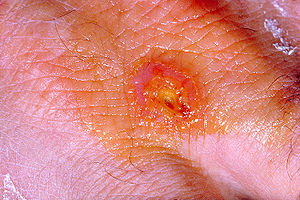Tularemia
| Tularemia | |
|---|---|
| Synonyms | tularaemia, Pahvant Valley plague, rabbit fever, deer fly fever, Ohara's fever |
 |
|
| A tularemia lesion on the dorsal skin of the right hand | |
| Classification and external resources | |
| Specialty | infectious disease |
| ICD-10 | A21 |
| ICD-9-CM | 021 |
| DiseasesDB | 13454 |
| MedlinePlus | 000856 |
| eMedicine | med/2326 emerg/591 ped/2327 |
| Patient UK | Tularemia |
| MeSH | D014406 |
Tularemia is a serious infectious disease caused by the intracellular bacterium Francisella tularensis. It causes fever, and sometimes ulceration at the site of entry and/or swelling of nearby lymph nodes. It can cause severe pneumonia.
A Gram-negative coccobacillus, Francisella tularensis has several subspecies with varying degrees of virulence. The most important of those is F. tularensis tularensis (Type A), which is found in lagomorphs (rabbits, hares and pikas) in North America, and it is highly virulent in humans and domestic rabbits. F. tularensis palaearctica (Type B) occurs mainly in aquatic rodents (beavers, muskrats) in North America and in hares and small rodents in northern Eurasia. It is less virulent for humans and rabbits. The primary vectors are ticks and deer flies, but the disease can also be spread through other arthropods. The disease is named after Tulare County, California.
Depending on the site of infection, tularemia has six characteristic clinical variants: ulceroglandular (the most common type representing 75% of all forms), glandular, oropharyngeal, pneumonic, oculoglandular, and typhoidal.
The incubation period for tularemia is one to 14 days; most human infections become apparent after three to five days. In most susceptible mammals, the clinical signs include fever, lethargy, loss of appetite, signs of sepsis, and possibly death. Nonhuman mammals rarely develop the skin lesions seen in people. Subclinical infections are common, and animals often develop specific antibodies to the organism. Fever is moderate or very high, and tularemia bacilli can be isolated from blood cultures at this stage. The face and eyes redden and become inflamed. Inflammation spreads to the lymph nodes, which enlarge and may (mimicking bubonic plague). Lymph node involvement is accompanied by a high fever.
...
Wikipedia
